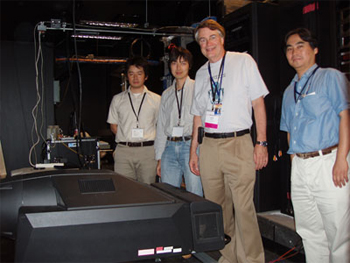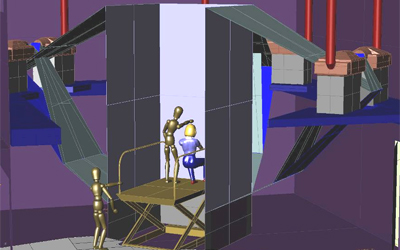Sony Large Venue Projector Sets Stage for 4KAVE Virtual Reality Environment
San Diego, CA, July 18, 2006 – When the California Institute for Telecommunications and Information Technology (Calit2) opened its new 200-seat auditorium, it needed a projector capable of delivering images at resolutions that mirrored reality as closely as possible. The research organization found that in the Sony SXRD™ 4K large-venue projector fit the bill, and Calit2 is making plans for an ambitious virtual-reality environment that would offer scientists 24 million pixels--nearly four times the pixels available from a single SXRD projector.
|
“We needed a projector with enough brightness to illuminate a 20-by-30-foot movie-theater-style screen,” says Larry Smarr, founding director of Calit2. “We also needed the color and contrast to be the best available so that each person in the auditorium – whether near to the screen or far – could see with the same degree of clarity.”
Calit2 at UCSD was among the first to receive Sony’s 4K SXRD projector and has utilized the technology in its auditorium since its debut at the iGrid 2005 workshop last fall.
Calit2 can now generate theater-size images in 4K resolution, a reference to the projector’s 4096 x 2160 pixel matrix, or approximately 8.8 million pixels, enabling it to deliver four times the resolution of current high-definition home theater systems.
In addition, the Sony projector is able to receive 4K images from a wide variety of sources, including digital still cameras, scanned film, live imagery and computers. This enables applications such as “telepresence” conferencing, in which participants feel more connected to members of teleconferences due to the high resolution of the images.
“The human eye has a finite resolution at which it can’t tell the difference between a projected image and reality,” said Smarr. “The 4K resolution generated by the Sony projector is definitely on the ‘other side of the rainbow.’ Calit2 always has the best visualization products, but this projector has really knocked me out.”
|
“I am very impressed with how versatile the projector is in handling a wide variety of source imagery,” said Smarr. “I believe that 4K can become a general tool for showing multi-megapixel images in wider applications beyond cinema, such as science, engineering and medicine.”
In fact, according to Smarr, the technology has worked so well that Calit2 now has plans to create a virtual-reality environment of multiple high-resolution projectors. As of now, the plan is for a 4KAVE immersive environment with four walls, and two projectors per wall, projecting 24 million pixels (nearly triple that of the current 4K projector on its own). Scientists inside the 'box' would be suspended on a raised platform roughly ten feet off the ground, and could immerse themselves in visual representations of their data displayed all around them). There are also plans to incorporate the projector into the facility’s OptIPuter project. The OptIPuter, which is funded by the National Science Foundation, creates “super-networks” by coupling computer resources over dedicated parallel optical Internet Protocol (IP) networks.
“The OptIPuter generates 200 times the bandwidth of currently available networks,” said Smarr. “This allows us to open up the world of visualization to the 4K resolution available from the Sony projector, paving the way for applications such as digital cinema and interactive telepresence.”


